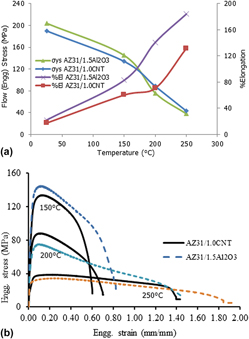Article contents
Study of comparative effectiveness of thermally stable nanoparticles on high temperature deformability of wrought AZ31 alloy
Published online by Cambridge University Press: 03 June 2014
Abstract

Thermally stable nanosized Al2O3 particles and carbon nanotubes (CNTs) are comparatively effective in simultaneous improvement of strength and ductility of wrought magnesium alloy AZ31 when incorporated in microstructure. Understanding the comparative effectiveness of these nanosized reinforcements on the high temperature deformation process of wrought AZ31 alloy is important for its potential wider automotive body application. The current study has revealed that both reinforcements are competitively effective in inducing matrix grain and intermetallic particles refinement and strengthening almost to a theoretically predicted value. Although high temperature flow stress of AZ31 was found to closely match due to incorporation of both of the nanosized reinforcements, alumina was more efficient in improving the failure strain of matrix alloy. Addition of remarkably a small amount of nanosized alumina particles or CNTs introduced huge potential in near net shape formability of AZ31 alloy at a temperature much below than the widely used 350 °C. Among the two reinforcements used in this study, alumina was found to be more efficient when compared to the effect of CNTs.
- Type
- Articles
- Information
- Copyright
- Copyright © Materials Research Society 2014
References
REFERENCES
- 3
- Cited by




